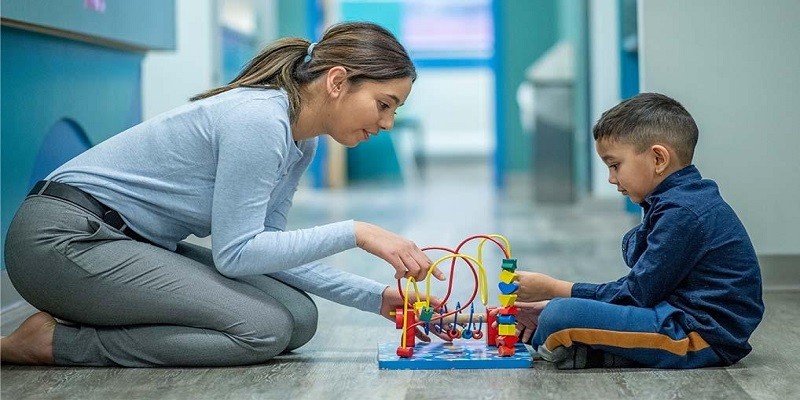Last Updated on January 15, 2025
A child may need occupational therapy to address challenges related to physical, sensory, cognitive, or social-emotional development. Occupational therapy helps children develop the skills necessary for daily activities and promotes their independence and overall well-being.
It can aid in improving motor skills, coordination, sensory integration, and self-care abilities. Additionally, occupational therapy can assist with enhancing attention, concentration, learning abilities, and emotional regulation. Occupational therapists use various techniques, such as play-based activities, exercises, and adaptive equipment, to support children in reaching their developmental milestones and participating fully in daily life.
What Is Occupational Therapy?
Occupational therapy plays a vital role in helping children overcome various developmental challenges that affect their everyday functioning. It focuses on enhancing a child’s ability to participate in activities they find meaningful and necessary for their growth and development. In this article, we will explore the definition of occupational therapy, its role in child development, and why a child may need this therapeutic intervention.
Definition Of Occupational Therapy
Occupational therapy, often abbreviated as OT, is a healthcare discipline that helps individuals of all ages develop or regain the skills needed to engage in meaningful activities. These activities, also known as “occupations,” include self-care, play, education, and social participation. Occupational therapists work holistically, taking into account physical, cognitive, sensory, and emotional aspects of an individual’s well-being to improve their overall quality of life.
Role Of Occupational Therapy In Child Development
Occupational therapy plays a crucial role in supporting the development of children who face challenges in various areas of their lives. This therapy addresses difficulties that may arise from conditions such as:
- Autism spectrum disorder
- Learning disabilities
- Cerebral palsy
- Developmental delays
- Attention deficit hyperactivity disorder (ADHD)
- Sensory processing disorders
Through tailored interventions, occupational therapists help children build the foundational skills required for daily activities, such as:
- Gross motor skills: Developing coordination, balance, and strength for activities like running, jumping, and climbing.
- Fine motor skills: Enhancing hand-eye coordination, finger dexterity, and manipulation abilities for tasks like writing, drawing, and buttoning clothes.
- Sensory processing: Assisting children in processing and integrating sensory information from their environment, helping them better understand and respond appropriately to various sensations.
- Social skills: Supporting children in developing social interaction skills, including communication, peer relationships, and understanding social cues.
- Self-care skills: Encouraging independence in activities of daily living, including dressing, feeding, grooming, and toileting.
- Play and leisure skills: Enabling children to participate in age-appropriate play activities, fostering creativity, imagination, and problem-solving abilities.
- Cognitive skills: Enhancing attention, concentration, memory, problem-solving, and organizational abilities.
Overall, occupational therapy empowers children to achieve their full potential and promotes their independence in all areas of life. By addressing specific challenges and working collaboratively with families and caregivers, occupational therapists help children thrive and succeed.

Credit: www.griffinot.com
The Role Of Occupational Therapy In Treating Children
Occupational therapy plays a vital role in helping children overcome various challenges and develop essential skills needed for daily life activities. By using a holistic approach, occupational therapists work with children to address any physical, sensory, cognitive, or behavioral obstacles they may be facing. In this section, we will explore the significance of occupational therapy in treating children, including how it can identify the need for therapy and the common conditions that can benefit from its intervention.
Identifying The Need For Occupational Therapy
Identifying the need for occupational therapy is crucial in ensuring that children receive the necessary support and interventions at the right time. While every child is unique, there are certain signs and indicators that suggest occupational therapy may be beneficial. Some of the ways to identify if a child may benefit from occupational therapy include:
- Difficulty with fine motor skills, such as holding a pencil or using scissors
- Challenges in self-care activities, like dressing, feeding, or using the toilet independently
- Trouble with sensory processing, resulting in sensitivity or aversion to certain textures, sounds, or movements
- Delayed or atypical development of gross motor skills, such as sitting, crawling, or walking
- Struggles in organizing and planning tasks
- Behavioral issues that hinder social participation and learning
It’s important to note that this list is not exhaustive, and each case should be evaluated by a qualified occupational therapist to determine the appropriate course of action. Early identification and intervention can significantly enhance a child’s chances of success in various areas of their lives.
Common Conditions That Can Benefit From Occupational Therapy
Occupational therapy has shown great effectiveness in assisting children with a wide range of conditions. Some of the common conditions that can benefit from occupational therapy include:
- Autism spectrum disorders
- Attention-deficit/hyperactivity disorder (ADHD)
- Cerebral palsy
- Developmental delays
- Learning disabilities
- Genetic disorders
- Sensory processing disorders
- Behavioral disorders
- Physical disabilities
Occupational therapists work closely with children diagnosed with these conditions, tailoring interventions to their specific needs and goals. Through a combination of exercises, activities, adaptive equipment, and environmental modifications, occupational therapy aims to improve a child’s independence, enhance their cognitive and physical abilities, and enable them to participate fully in their daily routines and social interactions.
Signs That Indicate A Child May Need Occupational Therapy
Occupational therapy plays a crucial role in helping children overcome challenges and achieve their full potential. Whether a child is struggling with motor skills development, sensory processing, or daily living activities, occupational therapy can provide the necessary support and interventions. Recognizing the signs that indicate a child may need occupational therapy is essential for early identification and intervention. In this section, we will explore the common signs that parents and caregivers should look out for.
Motor Skills Development Delays And Difficulties
Motor skills development refers to a child’s ability to use and control their muscles to perform tasks effectively. When a child experiences delays or difficulties in motor skills development, it can impact their overall growth and independence. Key signs that may indicate a need for occupational therapy in this area include:
- Delay in achieving developmental milestones such as crawling, walking, and running
- Poor coordination and balance
- Difficulty with fine motor skills, such as writing, buttoning clothes, or using utensils
- Lack of hand-eye coordination, making it challenging to catch or throw a ball
- Weak muscle strength and control
By addressing motor skills development delays and difficulties through occupational therapy, children can improve their physical abilities, enhance their self-confidence, and better participate in everyday activities.
Sensory Processing Issues And Challenges
Sensory processing refers to how the brain receives and responds to information from the senses. Some children may struggle with sensory processing, leading to difficulties in regulating and integrating sensory input. Signs that may indicate a need for occupational therapy in this area include:
- Hypersensitivity or hyposensitivity to sensory stimuli, such as excessive reactions to loud noises or a lack of response to pain
- Difficulty with sensory modulation, resulting in emotional or behavioral challenges
- Intolerance to certain textures, tastes, or smells
- Withdrawal from or seeking out sensory experiences excessively
- Difficulty with self-regulation and adapting to different environments
Through targeted occupational therapy interventions, children with sensory processing issues can learn to manage sensory input more effectively, improve their self-regulation, and enhance their overall well-being.
Difficulty With Daily Living Activities
Daily living activities refer to the essential tasks that children need to perform independently, such as dressing, eating, and grooming. Some children may experience challenges in these areas, impacting their ability to be self-sufficient. Signs that may indicate a need for occupational therapy in this area include:
- Difficulty with fine motor skills required for tasks like tying shoelaces or zipping up a jacket
- Struggles with gross motor skills needed for activities like climbing stairs or riding a bike
- Inability to maintain attention and focus during daily routines
- Resistance or difficulties in transitioning between activities
- Delayed or limited independence in self-care tasks
Occupational therapy can provide children with the necessary strategies and interventions to improve their daily living skills, increase their independence, and promote their overall well-being.
Benefits Of Occupational Therapy For Children
Improving Motor Skills And Coordination
Occupational therapy can play a vital role in enhancing a child’s motor skills and coordination, allowing them to navigate their physical world with confidence and independence. Through a variety of engaging and interactive activities, occupational therapists help children develop their fine motor skills, such as grasping objects, writing, and using utensils. They also work on improving gross motor skills, including balance, coordination, and strength. By addressing any challenges or delays in these areas, occupational therapy maximizes a child’s potential for physical success.
Enhancing Sensory Processing And Integration
Sensory processing and integration are crucial components of a child’s overall development. Occupational therapy provides children with the tools and strategies they need to better understand and manage sensory information from their environment. Through sensory-rich activities, occupational therapists help children regulate their responses to sensory stimuli, ultimately improving their ability to focus, engage, and participate in daily activities.
Facilitating Independence In Daily Activities
Occupational therapy empowers children to become more independent in their daily activities. By breaking tasks down into manageable steps and using adaptive techniques and strategies, occupational therapists help children overcome any difficulties they may face in activities such as dressing, feeding, grooming, and self-care. Occupational therapy not only teaches children the necessary skills but also fosters a sense of confidence and self-reliance, enabling them to participate fully in their daily lives.
Occupational Therapy Techniques For Children
Occupational therapy techniques are highly beneficial for children who may be experiencing difficulties in various areas of their development. These techniques are designed to help children enhance their skills and overcome challenges that may be affecting their daily routines or academic performance. Occupational therapists use a range of interventions and strategies tailored to the unique needs of each child. Here are three occupational therapy techniques commonly used with children:
Play-based Interventions
Play-based interventions are a fundamental aspect of occupational therapy for children as they provide a fun and engaging way to work on various skills. Through play, therapists help children develop their social, cognitive, and physical abilities. Play-based interventions can involve board games, building blocks, roleplay activities, and puzzles, among others. Therapists carefully select activities that address specific areas of concern, such as problem-solving, coordination, communication, and fine motor skills.
Sensory Integration Therapy
Sensory integration therapy focuses on helping children who struggle with processing sensory information. Many children with conditions like autism spectrum disorder or sensory processing disorder may have difficulty organizing and responding to sensory stimuli. Sensory integration therapy aims to improve these challenges by exposing children to sensory experiences in a structured and supportive environment. Occupational therapists may use activities involving touch, movement, sound, and visual stimulation to assist children in regulating their sensory responses and promoting effective sensory integration.
Fine Motor Skill Development Exercises
Fine motor skill development exercises are often a core component of occupational therapy for children as they target the refinement of hand and finger movements necessary for activities like writing, drawing, buttoning clothes, and using utensils. These exercises help children improve their hand-eye coordination, dexterity, grip strength, and manual control. Occupational therapists may utilize various techniques, such as finger strengthening exercises, scissor skills practice, threading beads, and manipulating small objects. These exercises are essential for children who struggle with fine motor skills due to conditions like developmental coordination disorder or difficulties with muscle control.
Occupational therapy techniques for children are highly effective in addressing a wide range of difficulties and challenges they may face in their daily lives. By engaging children in play-based interventions, sensory integration therapy, and fine motor skill development exercises, occupational therapists provide targeted support that encourages progress, enhances independence, and facilitates overall development.
Collaborating With Occupational Therapists And Other Professionals
When it comes to providing comprehensive care for children in need of occupational therapy, collaboration between occupational therapists and other professionals is crucial. This multidisciplinary approach ensures that all aspects of a child’s development and well-being are addressed effectively. By working together, healthcare professionals, educators, and parents can create an integrated support system that maximizes the potential for positive outcomes.
Importance Of A Multidisciplinary Approach
A multidisciplinary approach brings together experts from various fields to provide a holistic assessment of a child’s needs. Occupational therapists collaborate with professionals such as speech-language pathologists, physical therapists, psychologists, and educators. This collaboration allows for a comprehensive evaluation and treatment plan, considering all factors that influence a child’s development.
Through a multidisciplinary approach, different professionals can assess the child’s strengths and challenges from their unique perspectives. This comprehensive assessment helps to identify the underlying factors that may be affecting the child’s daily functioning, such as sensory processing issues, motor coordination difficulties, or cognitive impairments. By merging their expertise, professionals can formulate tailored intervention strategies that target the specific needs of the child.
Role Of Parents And Caregivers In Therapy, Ensuring Each H3 Heading Adheres To Html Syntax
Parents and caregivers play a vital role in their child’s occupational therapy journey. Their involvement in therapy sessions, as well as their active participation in the child’s daily life, greatly enhances the effectiveness of the intervention. By collaborating closely with occupational therapists and other professionals, parents and caregivers can extend the benefits of therapy beyond the treatment sessions.
Here are key ways parents and caregivers contribute to the therapy process:
- Acting as advocates: Parents and caregivers have unique insights into their child’s needs and can effectively communicate these to the therapy team. They can provide valuable information on the child’s routines, preferences, and challenges, enabling therapists to tailor interventions accordingly.
- Reinforcing therapy goals at home: Occupational therapists provide strategies and activities for parents and caregivers to implement at home. By incorporating these into the child’s daily routines, parents and caregivers can support the child’s progress and promote skill development.
- Collaborating with other professionals: In a multidisciplinary approach, parents and caregivers serve as bridges between different professionals involved in the child’s care. They ensure effective communication and coordination between professionals, facilitating a cohesive and integrated approach to therapy.
- Providing a supportive environment: Parents and caregivers create a nurturing and stimulating environment at home that encourages the child’s progress. By maintaining consistency and utilizing strategies learned during therapy, they can help the child transfer newly acquired skills to real-life situations.
When parents and caregivers actively engage in their child’s therapy journey, they become valuable partners in the intervention process. By collaborating with occupational therapists and other professionals, they ensure a holistic and consistent approach to support the child’s development and enhance therapy outcomes.
Frequently Asked Questions Of Why Would A Child Need Occupational Therapy?
What Are The Signs That Indicate A Child Might Need Occupational Therapy?
Occupational therapy might be necessary if a child struggles with fine motor skills, sensory processing issues, or self-regulation difficulties.
How Can Occupational Therapy Benefit A Child With Learning Disabilities?
Occupational therapy can help children with learning disabilities by improving their attention, focus, and organization skills, ultimately enhancing their academic performance.
Can Occupational Therapy Address Behavioral Challenges In Children?
Yes, occupational therapy can assist in addressing behavioral challenges by teaching children adaptive strategies to manage their emotions and develop appropriate social skills.
What Are The Common Conditions That Occupational Therapy Can Help Children With?
Occupational therapy can benefit children with conditions such as ADHD, autism spectrum disorder, developmental delay, and sensory processing disorder.
How Does Occupational Therapy Promote Independence In Children?
Through occupational therapy, children learn critical life skills like dressing, feeding, and organizing their belongings, supporting their independence and overall well-being.
Are There Any Long-term Benefits Of Occupational Therapy For Children?
Yes, occupational therapy can provide long-term benefits by enabling children to develop the necessary skills to overcome challenges and thrive throughout their lives.
Conclusion
In sum, occupational therapy can greatly benefit children by addressing various challenges they may face in their everyday lives. By focusing on enhancing their physical, cognitive, and sensory skills, occupational therapy helps children develop crucial foundational abilities necessary for independent functioning.
Whether a child is struggling with fine motor skills, sensory processing issues, or difficulties in social interactions, occupational therapy provides the necessary support and interventions to promote their overall development and well-being. Emphasizing a child-centered approach, occupational therapy ensures individualized care to facilitate each child’s unique needs and goals.







